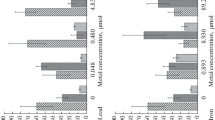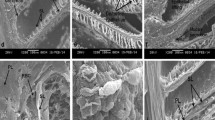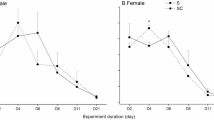Abstract
Freshwater clams,Anodonta cygnea, were treated during three months with the chitin-inhibitor, diflubenzuron (Dimilin® PH 60-40), suspended in water at a concentration of 200 mg/L. Cytochemical observations, carried out on the outer mantle epithelium (OME) of the treated and control animals, showed secretory cells with a periodic-acid Schiff (PAS) positive reaction and a negative reaction to enzymatic hydrolysis by amylase. However, morphological observations by scanning electron microscopy (SEM) showed that diflubenzuron strongly affects the normal calcification process on the lamellar layer of the shell, since the calcareous crystals do not form continuous layers, but rather disintegrated layers.
These observations suggest that diflubenzuron may block the polycondensation reactions to chitin chains in the OME secretory cells of the freshwater clam,Anodonta cygnea, producing unpolymerized chitin (unstablized chitin) only. Diflubenzuron suspended at this concentration (200 mg/L), is not directly toxic to freshwater clam,Anodonta cygnea; however, a more persistent (chronic) exposure to this chemical compound may render the shell breakable.
Similar content being viewed by others
References
Beedham GE (1954) Properties of the non-calcareous material in the shell ofAnodonta cygnea. Nature 174:750
Cardinal H, Vernet G, Sinegre G (1979) Quelques effets d'un inhibiteur de croissance: le diflubenzuron sur un crabeCarcinus mediterraneus (Czerniavsky). CR Soc Biol Sess Fil 173:1105–1108
Christiansen ME, Costlow JD, Monroe RJ (1978) Effects of the insect growth regulator Dimilin (TH 60-40) on larval development of two estuarine crabs. Mar Biol (Ber) 50:29–36
Clarke L, Temple GHR, Vincent JFV (1977) The effects of a chitin inhibitor Dimilin on the production of peritrophic membrane in the locust,Locusta migratoria. J Insect Physiol 23:241–246
Costlow JD (1979) Effect of Dimilin on development of larvae of the stone crabMenippe mercenaria and the blue crabCallinectes sapidus. In: Vernberg WB, Calabrese A, Thurberg FP, Vernberg FJ (eds) Marine pollution: Functional responses. Academic Press, New York, pp 355–364
Crenshaw MA (1982) Mechanisms of normal biological mineralization of calcium carbonates. In: Nancollas GH (ed) Biological mineralization and demineralization. Springer-Verlag, Berlin, pp 243–257
Cunningham PA (1976) Effects of Dimilin (TH 60-40) on reproduction in the brine shrimpArtemia salina. Environ Entomol 5:701–706
Cunningham PA, Myers LE (1987) Effects of diflubenzuron (Dimilin) on survival, molting, and behavior of juvenile fiddler crabs,Uca pugilator. Arch Environ Contam Toxicol 16(6):745–752
Cunningham PA, Wilson JE, Evans DW, Costlow JD (1985) Effects of sediment on the persistence and toxicity of diflubenzuron (Dimilin) in estuarine waters: A laboratory evaluation using larvae of two estuarine crustaceans. In: Vernberg WB, Calabrese A, Thurberg FP, Vernberg FJ (eds) Pollution physiology of estuarine organisms. Univ of S. Carolina Press, Columbia, SC pp 299–331
Gabe M (1968) Détection histochimique des polysaccharides. In: Gabe M (ed) Techniques histologiques. Masson et Cie, Paris, pp 400–446
Greenfield EM, Wilson DC, Crenshaw MA (1984) Ionotropic nucleation of calcium carbonate by molluscan matrix. Amer Zool 24:925–932
Gulka G, Doscher CM, Watabe N (1980) Toxicity and molt-accelerating effects of diflubenzuron on the barnacle,Balanus eburneus. Bull Environ Contam Toxicol 25:477–481
Hunter E, Vincent JFV (1974) The effects of a novel insecticide on insect cuticle. Experientia 30:1432–1433
Julin AM, Sanders HO (1978) Toxicity of the IGR, diflubenzuron, to freshwater invertebrates and fishes. Mosquito News 38(2):256–259
Krampitz G, Drolshagen H, Hausle J, Hof-Irmscher K (1983) Organic matrix of mollusc shells. In: Westbroek P, Jong FW (eds) Biomineralization and biological metal accumulation. D Reidel Publ Co, Dordrecht, Holland, pp 231–247
Machado J, Castilho F, Coimbra J, Sã C, Monteiro E, Reis ML (1988) Ultrastructural and cytochemical studies of the mantle ofAnodonta cygnea. Tissue and Cell (in press)
Mann S (1983) Mineralization in biological systems. Structure and Bonding 54:125–174
— (1988) Molecular recognition in biomineralization. Nature 332:119–124
Marks EP, Sowa BA (1976) Cuticle formationin vitro. In: Hepburn HR (ed) The insect integument, Elsevier, Amsterdam, pp 339–350
Miura T, Takahashi RM (1974) Insect development inhibitors. Effects of candidate mosquito control agents on non-target aquatic organisms. Environ Entomol 3:631–636
Mulder R, Gijswijt MJ (1973) The laboratory evaluation of two promising new insecticides which interfere with cuticle deposition. Pestic Sci 4:737–745
Nimmo DR, Hamaker TL, Moore JC, Wood RA (1980) Acute and chronic effects of Dimilin on survival and reproduction ofMysidopsis bahia. In: Eaton JG, Parrish PR, Hendricks AC (eds) Aquatic toxicology, STP 707. American Society for Testing and Materials, Philadelphia PA, pp 366–376
Post LC, De Jong BJ, Vincent WR (1974) 1-(2,6-disubstituted benzoyl)-3-phenylurea in insecticides: Inhibitors of chitin synthesis. Pest Biochem Physiol 4:473–483
Schaefer CH, Dupras EF (1976) Factors affecting the stability of Dimilin in water and the persistence of Dimilin in field waters. J Agric Food Chem 25:1026–1030
Van Eck WH (1979) Mode of action of two benzoylphenyl ureas as inhibitors of chitin synthesis in insects. Insect Biochem 9:295–300
Weiner S, Traub W, Lowenstam HA (1983) Organic matrix in calcified exoskeletons. In: Westbroek P, Jong EW (eds) Biomineralization and biological metal accumulation. D Reidel Publ Co, Dordrecht, Holland, pp 205–224
Weis JS, Cohen R, Kwiatkowsi JK (1987) Effects of diflubenzuron on limb regeneration and molting in the fiddler crab,Uca pugilator, Aquat Toxicol 10:279–290
Weis JS, Ma A (1987) Effects of the presticide diflubenzuron on larval horseshoe crabs,Limulus polyphemus. Bull Environ Contam Toxicol 39:224–228
Wheeler AP, Sikes CS (1984) Regulation of carbonate calcification by organic matrix. Amer Zool 24:933–944
Wilbur KM (1976) Recent studies of invertebrate mineralization. In: Watabe N, Wilbur KM (eds) The mechanisms of mineralization in the invertebrates and plants. Univ of S. Carolina Press, Columbia, SC pp 79–108
— (1984) Many minerals, several phyla, and a few considerations. Amer Zool 24:839–845
Wilbur KM, Simkiss K (1979) Carbonate turnover and deposition by metazoa. In: Trudinger PA, Swaine DJ (eds) Biogeochemical cycling of mineral-forming elements. Elsevier, Amsterdam, pp 69–106
Author information
Authors and Affiliations
Rights and permissions
About this article
Cite this article
Machado, J., Coimbra, J., Castilho, F. et al. Effects of diflubenzuron on shell formation of the freshwater clam,Anodonta cygnea . Arch. Environ. Contam. Toxicol. 19, 35–39 (1990). https://doi.org/10.1007/BF01059810
Received:
Revised:
Issue Date:
DOI: https://doi.org/10.1007/BF01059810




